Foster and Rahmstorf Measure the Global Warming Signal
Posted on 20 December 2011 by dana1981
Foster and Rahmstorf (2011) have published a paper in Environmental Research Letters seeking to extract the human-caused global warming signal from the global surface temperature and lower troposphere temperature data. In order to accomplish this goal, the authors effectively filter out the effects of solar activity, the El Niño Southern Oscillation (ENSO), and volcanic activity. The result is shown in Figure 1 below.
Figure 1: Annual averages of the adjusted data - the global warming signal
Foster and Rahmstorf characterize ENSO by using the Multivariate ENSO Index (MEI), aerosol optical thickness data (AOD) for volcanic activity, and solar irradiance data (from PMOD) to characterize solar activity. They also tried using Southern Oscillation Index (SOI) data for ENSO, sunspot number data for solar activity, and a volcanic radiative forcing reconstruction from Ammann et al. (2003), but found these changes made little difference to their results:
"None of these substitutions affected the results in a significant way, establishing that this analysis is robust to the choice of data to represent exogenous factors."
They approximated the influence of these exogeneous factors by using multiple regression of MEI, AOD, and PMOD on temperature data from GISS, NCDC, HadCRU, RSS, and UAH. Since those exogeneous factors can have a delayed effect on temperatures, they tested lag values from 0 to 24 months to see which best fit the data. The results are listed in Table 1.
Table 1: Warming rates in °C/decade for 1979-2010, and lag in months, for each of the five temperature records and each of the three exogenous factors. Numbers in parentheses are standard errors in the final digits of the estimated values.
As Table 1 shows, filtering out these external effects increased the 32-year warming trend in every data set except UAH. This analysis reveals that the underlying human-caused global warming trend in the surface temperature data ranges between 0.170 and 0.175°C per decade, and between 0.141 and 0.157°C per decade in the two main satellite lower troposphere temperature data sets.
This is a very similar result to Huber and Knutti (2011), who estimated that approximately 100% of the observed surface warming since the 1950s has been caused by human effects. This corresponds to approximately 0.55°C warming, most of which has occurred since mid-1970, for 0.15 to 0.20°C per decade anthropogenic warming, based on the Huber and Knutti results.
Additionally, we see that the lag before ENSO is reflected in surface temperature is 2 to 4 months, 5 to 7 months for volcanic effects, and 1 month for changes in solar activity. In the lower troposphere, the lags are 5, 5-6, and zero months, respectively. The authors conclude:
"When the fluctuations in temperature over the last 32 years (which tend to obscure the continuation of the global warming trend) are accounted for, it becomes obvious that there has not been any cessation, or even any slowing, of global warming over the last decade (or at any time during this time span). In other words, any deviations from an unchanging linear warming trend are explained by the influence of ENSO, volcanoes and solar variability....It is worthy of note that for all five adjusted data sets, 2009 and 2010 are the two hottest years on record....All five data sets show statistically significant warming even for the time span from 2000 to the present."
Overall, Foster and Rahmstorf find that ENSO has the largest impact on short-term temperature variations, followed by volcanic activity, with solar irradiance a distant third. However, the contributions of each factor to the 32-year temperature trends were very similar (Table 2, Figure 2).
Table 2: Trends in °C/decade of the signal components due to MEI, AOD and TSI in the regression of global temperature, for each of the five temperature records from 1979 to 2010.
Figure 2: Influence of exogenous factors on global temperature for GISS (blue) and RSS data (red). (a) MEI; (b) AOD; (c) TSI.
These factors contributed to very slight cooling of global temperatures over the past 32 years, with the execption of UAH, for which they have had no net impact on the trend. Figure 3 shows the temperature data before and after the Foster and Rahmstorf exogeneous factor removal.
Figure 3: Temperature data (with a 12-month running average) before and after the exogeneous factor removal
The authors conclude by averaging all of the data sets together (Figure 4):
"Because the effects of volcanic eruptions and of ENSO are very short-term and that of solar variability very small, none of these factors can be expected to exert a significant influence on the continuation of global warming over the coming decades. The close agreement between all five adjusted data sets suggests that it is meaningful to average them in order to produce a composite record of planetary warming. [Figure 3 shows] the true global warming signal."
Figure 4: Average of all five adjusted data sets.
Based on this average of all five adjusted data sets, the warming trend has not slowed significantly in recent years (0.163°C per decade from 1979 through 2010, 0.155°C per decade from 1998 through 2010, and 0.187°C per decade from 2000 through 2010). As Foster and Rahmstorf conclude,
"The resultant adjusted data show clearly, both visually and when subjected to statistical analysis, that the rate of global warming due to other factors (most likely these are exclusively anthropogenic) has been remarkably steady during the 32 years from 1979 through 2010. There is no indication of any slowdown or acceleration of global warming, beyond the variability induced by these known natural factors."
For more on this paper, see tamino's take.
Note: the Foster and Rahmstorf results have been incorporated into the rebuttals to It's the sun (Intermediate and Advanced), A drop in volcanic activity caused warming, It's El Niño, Global warming stopped in [insert year], It hasn't warmed since 1998, and It's cooling































 Arguments
Arguments





















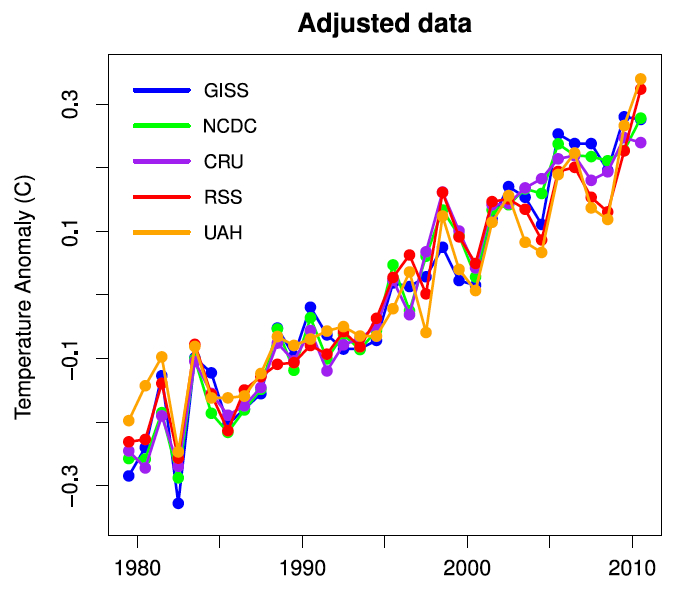
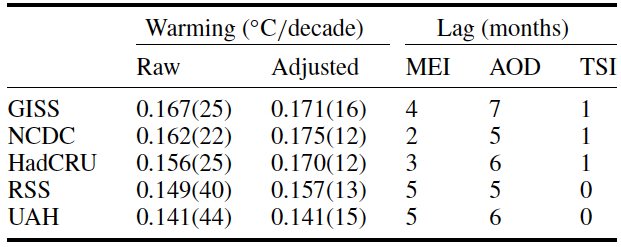
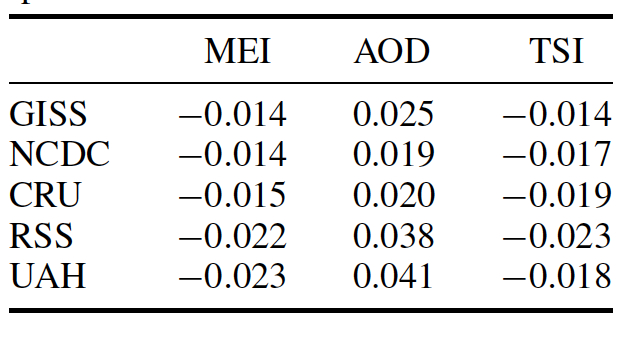

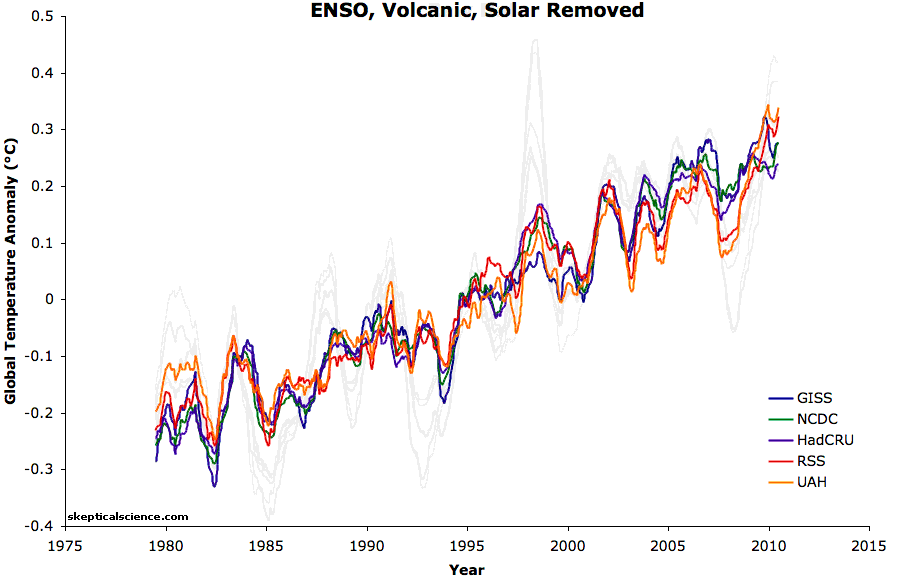
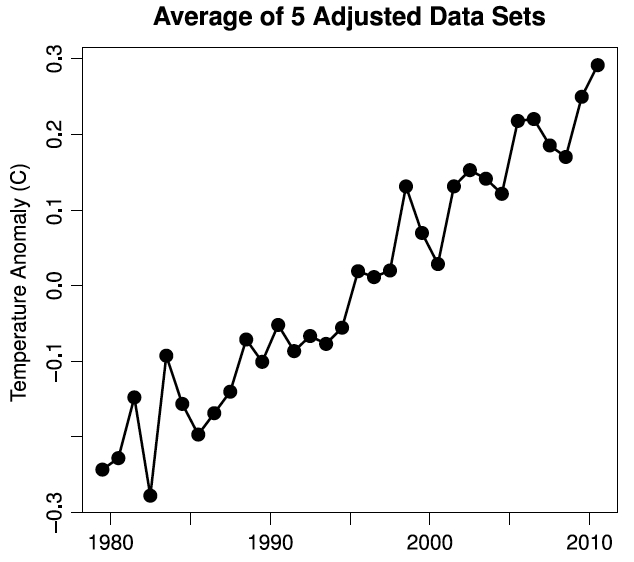









[DB] "it seems that it's mainly the ENSO that's had an effect over since 1998 to make it appear that global warming has ended, which is what the skeptic-deniers always claim"
You mean the denialist meme you are repeating?
"why is the cooling effect of the La Nina still so pronounced"
What cooling effect? Please read the OP again. You must've missed this bit:
[DB] "why aren't the La Ninas getting less pronounced?"
Who said the La Ninas would get less pronounced? The La Ninas themselves are warming up. The most recent La Nina was the warmest on record, warmer indeed than many El Ninos. What you are missing is the incomplete temperature monitoring of the ocean deeps. Thus, what may seem like a "cooling effect" in the surface temperature record (which statistically is still warming during the La Nina) misses the injection of heat into the deep. Essentially, ENSO causes a redistribution of heat (thus the use of the word "variations"), but overall does not warm nor cool the Earth.
In the face of said posited "cooling", ask yourself how it is then that the most recent decade is the warmest in the surface temperature record?
Elsewhere, RobertF writes:
"I am a sub-beginner and probably a bit skeptical of both sides. Recently, I saw a graph from Rahmstorf showing a continuing warming. A denier friend informs me that Rahmstorf cooked the books by adjusting for ENSO, in part. The rationale given is that ENSO has no direct global impact and thus surface temperatures cannot be adjusted for what is a local phenomenon. As justification, the denied offered a citation from Trenberth: "Although it is possible to use regression to eliminate the linear portion of the global mean temperature signal associated with ENSO, the processes that contribute regionally to the global mean differ considerably, and the linear approach likely leaves an ENSO residual."
What am I missing? Thanks in advance!"
Your "denier friend" is being no friend in feeding you such nonsense.
To begin with, the link between fluctuations in ENSO and changes in mean global surface temperatures is well established - and is the dominant short term (1-2 year) influence on global temperatures. This has been established by (among many more credible sources), the noted "skeptics", McLean, Carter and DeFreitas, who produced this figure comparing detrended middle atmosphere temperatures with the Southern Oscillation Index (SOI):
As you can see, except where there is volcanic cooling, the correlation is very close. Consequently there is no doubt that ENSO is responsible for most of the interannual variability in GMST. A fact so well established that even leading "skeptical" scientists are publishing on it is hardly one we should disagree with on the word of an anonymous friend.
(Note, use of this figure should not be taken as endorsement of McLean et al's ludicrous claim that because they show a correlation with the detrended GMST, therefore ENSO is responsible for the long term trend in GMST.)
So, given that there is an correlation, what are we to make of Trenberth's claim? You will note that he does not say there is no correlation, only that "a linear approach is likely to leave a residual". And if you look closely at the Foster and Rahmstorf adjusted data above, you will see exactly that residual. It is most obvious in the peak at 1998, and the trough in 2008 corresponding to the 1998 El Nino and the 2008 La Nina respectively.
"Leaving a residual" does not mean that there is no relation between ENSO and GMST as your friend would have you believe. It merely means that the effect is not a simple multiple of the strenght of the ENSO signal. Therefore any approach which treats it as such (including F&R) will leave a small part of the ENSO signal in the data, ie, a residual. The effect will be that such approaches will understate the effect of ENSO on short term temperature trends. Had F&R used a more sophisticated approach, they would have shown still stronger long trends over the last two decades than they actually show (although probably within statistical error of the trends they do show).
Of course, you do not need a sophisticated statistical method such as F&R to see what recent temperature trends would have been without the effect of ENSO. You merely need to group like with like - El Nino years with El Nino years, La Nina years with La Nina years - and thus determine the trend largely without any ENSO influence. John Neilson-Gammon has done exactly that:
As you can see, the trends for different types of years are approximately the same. Unsurprisingly, that trend, 0.16 C per decade, is very close to that found by F&R. (The slight difference is partly accounted for in that this method does not account for the recent cooling of the Sun.) More importantly, recent years fall very close to there respective trend lines. Therefore there has been very little recent cooling beyond the switch to a La Nina dominated pattern.
ENSO may not be the whole story in the recent lower trends in GMST. Scientists, being scientists, explore every possibility. But clearly ENSO is the dominant factor, and the other factors which scientists are exporing are additional effects - effects without which we would have seen an acceleration in global temperature rise. "Skeptics" like to drag those other studies across the trail to suggest ENSO is not a clear and dominant factor. The want to treat the diligence of scientists in exploring every factor as proof that no factor explored by scientists explains the recent lowered trends. But that is a simple pea and thimble game. Scientists know that ENSO is a dominant factor in the recent reduced trends. All that is at issue is how much of an effect it has had, and how much influence (if any) other less certain factors have had.